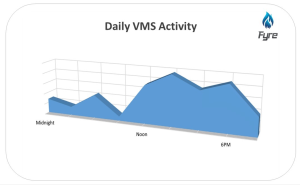 Ever have that fantasy where you can freeze and unfreeze time? I have. As the world stands still, I reshape the arc of a weak basketball shot and give myself the game-winning basket. Or, I sneak in an extra hour each day to learn a second language (or, let’s be honest, just take a nap). Freezing time is a common fantasy because sometimes all you need is a few seconds to change an entire course of events. In recruiting, it is certainly true. Every second counts when your job is to reach the best candidates first.
Ever have that fantasy where you can freeze and unfreeze time? I have. As the world stands still, I reshape the arc of a weak basketball shot and give myself the game-winning basket. Or, I sneak in an extra hour each day to learn a second language (or, let’s be honest, just take a nap). Freezing time is a common fantasy because sometimes all you need is a few seconds to change an entire course of events. In recruiting, it is certainly true. Every second counts when your job is to reach the best candidates first.
Today’s staffing firms — and their hardworking recruiters — are racing the clock as never before. With technology continuing to accelerate communications, the time you have to connect with candidates has never been so important or so short. Do you know where your staffing firm is losing critical recruiting time and ground to competitors? The answer to that question (as well as the solution for winning back recruiting time) lies in the gaps between the many technologies that drive today’s staffing life cycle.
Filling in Gaps, Losing Valuable Time
In staffing today, lots of disparate systems have to talk to each other for recruiting to be effective and placements to be swift and accurate. A substantial amount of recruiter time is spent bringing information from one system into another. From ATSs and VMSs to job boards and social media, information is everywhere and, for most staffing firms, data entry is what it takes to get those systems aligned and working together. It’s manual work, it’s tedious and it’s error prone. Ever pull up a half-completed or inactive job requisition? You’re not alone.
Thousands of Hours from VMS to ATS
Every day, recruiters at staffing firms large and small lose significant time copying and pasting requisitions from the VMS to the ATS. At large staffing firms, I have met staff members whose full-time job is entering VMS data into the company’s ATS. Even if that resource is clerical at $12/per hour, that work adds up to thousands of resource hours (2,000 annually) and thousands of dollars in salary and benefits dedicated to keeping information moving between systems.
For smaller staffing firms, this cutting and pasting of data from the VMS to the internal system is often the job of recruiters. While the VMS workload is smaller at these firms, it can still take an hour or two a day for each recruiter to do this mundane work.
According to our VMS analytics, requisition syncing activity spikes at two key periods in the course of a day. As the chart here demonstrates, we see a major spike in the early afternoon that stays strong until about 9pm. The second spike begins around 4am and drops off at about 10am.
For clients with automated syncing, these early morning and afternoon spikes integrate smoothly into the daily workflow. Synching technologies immediately upload VMS requisitions to the ATS and recruiters can push ahead move onto the new opportunities without any data entry delays. For businesses that require manual uploading, these spikes represent challenging bottlenecks. As requisitions flow in hot and heavy during these two key periods, they are piling up on desks.
Can a business afford to lose key segments of the day and of a recruiter’s productivity to data entry? Consider that while recruiters are entering and parsing data, competing recruiters without data entry tasks are using that time wisely. They have more time to build strong candidate relationships and carefully assess talent—making the kind of informed placements that are critical to both client and candidate satisfaction and loyalty.
PREMIUM CONTENT: Why some buyers don’t use VMS
Identify Your Problem Areas
What’s a staffing firm to do when data and systems require hours, minutes and seconds from recruiting time? To win back that time, start by identifying all the areas where recruiters and staff are losing hours to technology-related data entry:
- Ask recruiters to track their time over the course of a week. Calculate how much time is used on requisition uploading and parsing to determine if you’re paying too much for data entry.
- Analyze how much work time recruiters lose maneuvering between disparate systems (VMS, ATS, job boards, social media, etc.) and updating them. How can you simplify their workflows?
- Spot check the accuracy of requisitions across your ATS. If error rates are high or requisition information is often outdated, you’ve found another place where data entry is costing you time.
Once you see exactly where and how much time is slipping away, you can make a plan to win it back with better processes and automation tools. That’s actually how our company came to be. Before we formed a software firm, we were once recruiters who were losing far too many hours processing and pasting VMS data.
I am not saying staffing leaders have to become software developers or time-freezing wizards to win back critical recruiting time. Instead, I am saying it’s time to get fed up with all the time and talent that data entry is taking away from your business and make strategic changes. Explore what more hours, more minutes and more seconds of focused recruiting work can do for your sourcing results and placement success. And hurry, time is precious.
MORE: VMS set to expand in 2016









